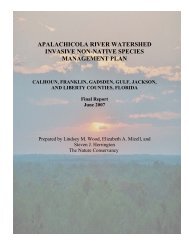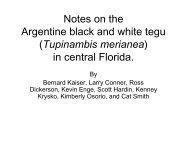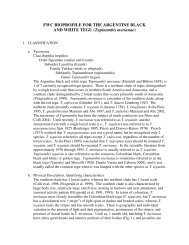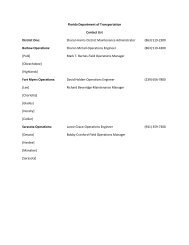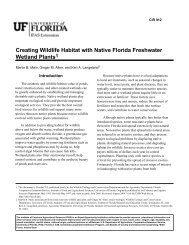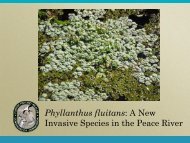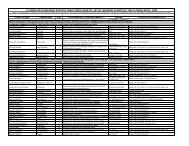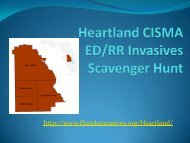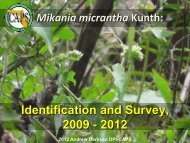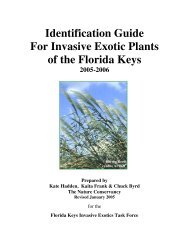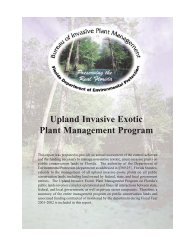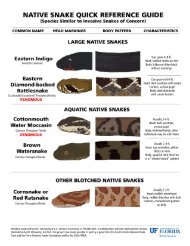2011 Grass Carp Presentation - Florida Invasive Species Partnership
2011 Grass Carp Presentation - Florida Invasive Species Partnership
2011 Grass Carp Presentation - Florida Invasive Species Partnership
Create successful ePaper yourself
Turn your PDF publications into a flip-book with our unique Google optimized e-Paper software.
Triploid <strong>Grass</strong> <strong>Carp</strong> and<br />
Aquatic Plant Management
A Brief History<br />
� Scientific Name: Ctenopharyngodon idella<br />
� Common Names: grass carp, white amur<br />
� Native to large river systems in Asia<br />
� <strong>Grass</strong> carp can now be found in 45 states<br />
(except Alaska, Maine, Montana, Rhode Island,<br />
and Vermont)
A Brief History (cont.)<br />
� First imported to the U.S. in 1963 to control<br />
aquatic vegetation in aquaculture ponds<br />
� Reproducing population was discovered in 1971 in<br />
the Mississippi drainage system<br />
� Sterile carp were first produced in the U.S. in 1979<br />
as inter-specific crosses between female grass<br />
carp and male bighead carp Aristichthys nobilis<br />
(Malone 1982)<br />
� Currently found in 93 countries
Commonly Reach 30 lbs or More<br />
Record weight is 99 lbs; length is 4.9 feet
Typically Live 10-15 Years,Unless…<br />
Largemouth Bass by FWC<br />
American Alligator by SFWMD<br />
River Otter by FWC<br />
Osprey by www.wildphotosphotography.com
Triploid Production<br />
Eggs are subjected to hydrostatic pressure<br />
resulting in three sets of chromosomes –<br />
rendering the fish sterile
<strong>Grass</strong> <strong>Carp</strong> Feeding Preferences<br />
Frequently Eaten<br />
� Brazilian elodea<br />
� Duckweed<br />
� Elodea<br />
� Hydrilla<br />
� Musk <strong>Grass</strong> (Chara)<br />
� Pondweed<br />
� Slender Spikerush<br />
� Southern Naiad<br />
� Widgeon <strong>Grass</strong> Hydrilla<br />
By Michael Sowinski FWC
<strong>Grass</strong> <strong>Carp</strong> Feeding Preferences<br />
Sometimes Eaten<br />
� Algae, Filamentous<br />
� Baby Tears<br />
� Bacopa<br />
� Banana Lily<br />
� Bladderwort<br />
� Bog Moss<br />
� Bulrush<br />
� Cattail<br />
� Coontail<br />
� Fanwort<br />
� Hygrophila<br />
Bog Moss<br />
By Michael Sowinski FWC
<strong>Grass</strong> <strong>Carp</strong> Feeding Preferences<br />
Sometimes Eaten (continued)<br />
� Knotgrass<br />
� Limnophila<br />
� Maidencane<br />
� Naiad, Marine<br />
� Nitella (Stonewort)<br />
� Rush Fuirena<br />
� Soft Rush<br />
� Southern Water grass<br />
� Spikerush<br />
� Water Meal<br />
� Water Shield<br />
By Michael Sowinski FWC<br />
Jointed Spikerush
<strong>Grass</strong> <strong>Carp</strong> Feeding Preferences<br />
Rarely Eaten<br />
� Algae, Planktonic<br />
� Alligator Weed<br />
� American Lotus<br />
� Azolla (Mosquito Fern)<br />
� Burhead Sedge<br />
� Common Arrowhead<br />
� Duck Potato<br />
� Frog’s Bit<br />
� Para <strong>Grass</strong><br />
� Parrot’s Feather<br />
� Pennywort (Dollarweed)<br />
� Pickerelweed<br />
By Michael Sowinski FWC<br />
American Lotus
<strong>Grass</strong> <strong>Carp</strong> Feeding Preferences<br />
Rarely Eaten (continued)<br />
� Red Ludwigia<br />
� Salvinia<br />
� Sawgrass<br />
� Sedges<br />
� Smartweed<br />
� Spatterdock<br />
� Torpedo grass<br />
� Water Paspalum<br />
� Water Hyacinth<br />
� Water Lettuce<br />
� Water Lilies<br />
� Wild Taro<br />
Smartweed<br />
By Michael Sowinski FWC
Permit Status in Southeast US<br />
State Status Genetic Requirements<br />
Alabama Legal - no permits required Diploid or triploid<br />
Arkansas Legal - no permits required Diploid or triploid<br />
<strong>Florida</strong> Legal - permit required Triploid only<br />
Georgia Legal - permit required Triploid only<br />
Kentucky Legal - permit required Triploid only<br />
Louisiana Legal - permit required Triploid only<br />
Mississippi Legal - permit required Diploid or triploid<br />
North Carolina Legal - permit required Triploid only<br />
Oklahoma Legal - no permits required Diploid or triploid<br />
Puerto Rico Legal - dealers permitted Diploid or triploid<br />
South Carolina Legal - permit required Triploid only<br />
Tennessee Legal - dealers permitted Triploid only<br />
Texas Legal - permit required Triploid only<br />
Virginia Legal - permit required Triploid only<br />
Virgin Islands Legal - not available Diploid or triploid<br />
From the Southern Regional Aquaculture Center (SRAC) July 2002 Publication
<strong>Florida</strong> Online Permitting<br />
Permits may be obtained online if the following<br />
criteria are met:<br />
� Single Owner<br />
� No inlets or outlets exist where fish can escape<br />
� No mitigation or water quality requirements<br />
� Applying for 50 fish or less<br />
� Size of the pond(s) is less than 5 acres
<strong>Grass</strong> <strong>Carp</strong> Regions
Permits Issued Statewide<br />
Fiscal Year Total Permits Issued New Permits Amendments<br />
2006/2007 1,698* 1,063 635*<br />
2007/2008 1,529 1,063 466<br />
2008/2009 1,343 801 542<br />
2009/2010 1,442 846 596<br />
2010/<strong>2011</strong> 1,472 817 655
Fish Barriers<br />
� Need to be of sturdy<br />
construction<br />
� Gaps must be: 1.25” for<br />
10” fish; 1.5” for 12”<br />
� Bars can be vertical or<br />
horizontal<br />
� Overflow should allow<br />
for major rain events to<br />
alleviate flooding
Barrier Issues<br />
Poor Construction Need to be Maintained
Barrier Issues II<br />
Underwater Pipes Poor Design
Stocking Rates<br />
Stocking rates are difficult to predict due to:<br />
� differences in vegetation coverage and<br />
densities, (e.g., total plant acreage compared to<br />
total water body acreage)<br />
� plant species present<br />
� weather events (e.g., droughts, hurricanes)
Stocking Rates (cont.)<br />
For 100% coverage of small ponds (
Public Lakes<br />
� A stocking request is sent to FWC<br />
� The South/Southwest Regional <strong>Grass</strong> <strong>Carp</strong> Team:<br />
� <strong>Invasive</strong> Plant Management Regional Biologist<br />
� Former Regional <strong>Grass</strong> <strong>Carp</strong> Biologist<br />
� Waterfowl Biologist<br />
� Freshwater Fisheries Biologist<br />
� Aquatic Habitat Restoration & Enhancement Section Biologist<br />
� The Regional <strong>Grass</strong> <strong>Carp</strong> Team reviews the request, inspects the<br />
waterbody (if necessary), and determines if the stocking of TGC<br />
will be a benefit to the waterbody
Just a Reminder!<br />
� Better to be very conservative in large water<br />
bodies using acres of vegetation instead of<br />
water surface acres<br />
� There is always the possibility of the lake<br />
becoming totally devoid of aquatic vegetation<br />
� Use an adaptive management approach<br />
� Be patient!!!<br />
� Questions call Rhonda Howell at 352-357-2951
Michael Sowinski – <strong>Florida</strong> Fish & Wildlife Conservation Commission<br />
2001 Homeland-Garfield Road, Bartow FL 33830<br />
michael.sowinski@myfwc.com<br />
Office: 863-534-7074 x230, Fax: 863-534-7181



